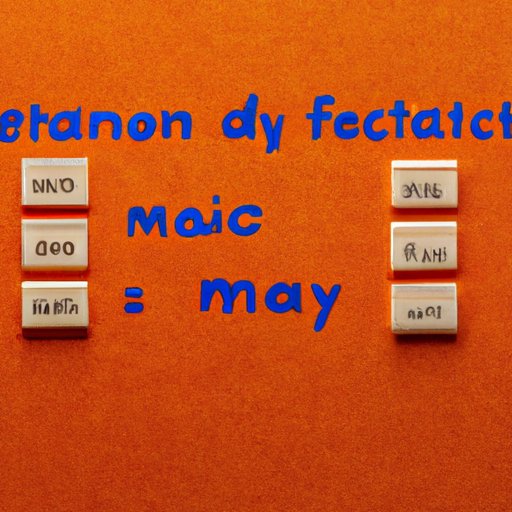Introduction
Knowing how to convert a fraction to a decimal is important for a variety of reasons, from calculating measurements in cooking to working on complex math problems. For example, when dividing a cake into equal portions, it’s necessary to understand the relationship between fractions and decimals to determine the right portion size. In this article, we’ll break down the steps of converting fractions to decimals, and provide helpful tips and tricks.
Understanding the Relationship Between Fractions and Decimals
Fractions are numerical values that represent a portion of a whole. Decimals, on the other hand, represent a number in base 10, or tenths. Decimals are related to fractions in that they represent the same value in a different form. For example, ½ can be written as 0.5 in decimal form.
In real life, fractions and decimals are used in many situations. For instance, when baking a cake, it’s necessary to use fractions to measure the ingredients accurately. Another example is when shopping, we might need to calculate the percentage off the total price, which requires converting fractions to decimals.
Breaking Down the Math: How to Convert Fractions to Decimals
There are two main ways to convert fractions to decimals: division and multiplication. With division, you divide the numerator by the denominator to get the decimal. With multiplication, you multiply the denominator by a multiple of 10 until it becomes a power of 10.
For example, to convert ¼ to a decimal, you could divide 1 by 4 to get 0.25, or multiply the numerator and denominator by 25 to get 0.25.
When deciding which method to use, it’s important to choose the method that is easiest and most efficient for the specific fraction you are trying to convert.
7 Simple Steps to Convert a Fraction to a Decimal
Here are the seven steps to convert a fraction to a decimal:
- Divide the numerator by the denominator
- Example: 3/4 = 0.75
- If the fraction isn’t easily divisible, use long division
- Example: 7/9 = 0.7777777…
- Multiply the denominator by a multiple of 10 until it becomes a power of 10
- Example: 1/8 = 1 x 125/8 x 125 = 0.125
- Remove the fraction bar and write as a decimal
- Example: 2/5 = 0.4
- Round the decimal to the desired place value
- Example: 2/3 = 0.6667 (rounded to four decimal places)
- Convert mixed numbers to improper fractions before converting to decimals
- Example: 1 3/5 = 8/5 = 1.6
- Use a calculator when necessary
- Example: 11/16 = 0.6875 (using a calculator)
Additional tips for converting fractions to decimals include looking for patterns and simplifying when possible. For example, 2/8 can be simplified to 1/4 before converting to a decimal.
Mastering the Art of Fraction to Decimal Conversion
Common mistakes to avoid when converting fractions to decimals include forgetting to round when necessary, using the wrong method (i.e. multiplying instead of dividing), and making computational errors. To avoid these mistakes, it’s important to practice regularly.
Here are three practice problems to work through:
- 1/2 = ?
- Solution: 0.5
- 2/3 = ?
- Solution: 0.6667 (rounded to four decimal places)
- 5/16 = ?
- Solution: 0.3125

Math Made Easy: Converting Fractions into Decimals
If you’re looking to improve your math skills, there are many resources available. Online tools like Khan Academy and Mathway offer lessons and practice problems, while books like “The Complete Idiot’s Guide to Algebra” and “Math for Real Life” provide step-by-step instructions.
Step-by-Step Guide to Convert Any Fraction to a Decimal
Here’s a recap of the main steps to follow when converting fractions to decimals:
- Determine which method to use (division or multiplication)
- Work through the steps outlined for the chosen method
- Round the decimal to the desired place value
For more complex fractions, it may be necessary to break the fraction down into smaller parts before converting to a decimal. For example, to convert 7/12 to a decimal, you could convert 1/2 and 1/6 separately and then add them together (0.5 + 0.1667 = 0.6667).
If you’re struggling with converting a specific fraction to a decimal, don’t hesitate to ask for help. Teachers, tutors, and online communities like Reddit’s math help forum can provide guidance and support.
Teaching Decimal Conversion: Simple Tricks and Tips for Fractions
When teaching others how to convert fractions to decimals, it’s important to break down the steps in a clear and concise manner. Encourage visual learners to draw diagrams or use manipulatives to help them understand the process.
Other tips for teaching decimal conversion include using real-life examples and making it fun. For example, when baking cookies, ask the student to convert the recipe’s measurements from fractions to decimals. Or, try playing a game where the student has to convert fractions to decimals as quickly as possible.
Remember that everyone learns differently, so be patient and try different teaching methods until you find what works best for the student.
Conclusion
Converting fractions to decimals is an essential skill in many areas of life, from cooking to finance to math. By following the simple steps outlined in this article, you can master the art of fraction to decimal conversion and give yourself a valuable tool for tackling a variety of problems.
Remember to practice regularly and seek help when needed. With dedication and hard work, you can become a fraction-to-decimal conversion expert.
